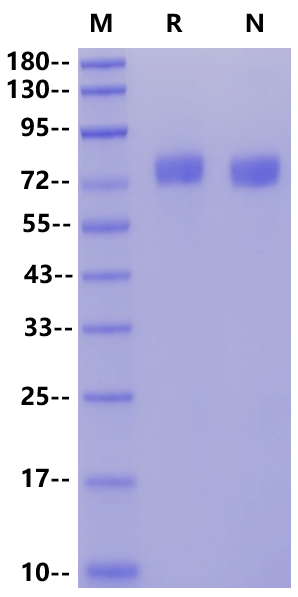Asp18-Gln528, with C-terminal 10*His DTICIGYHANNSTDTVDTVLEKNVTVTHSVNLLEDSHNGKLCRLKGIAPLQLGKCNIAGWLLGNPECDPLLPVRSWSYIVETPNSENGICYPGDFIDYEELREQLSSVSSFERFEIFPKESSWPNHNTNGVTAACSHEGKSSFYRNLLWLTEKEGSYPKLKNSYVNKKGKEVLVLWGIHHPPNSKEQQNLYQNENAYVSVVTSNYNRRFTPEIAERPKVRDQAGRMNYYWTLLKPGDTIIFEANGNLIAPMYAFALSRGFGSGIITSNASMHECNTKCQTPLGAINSSLPYQNIHPVTIGECPKYVRSAKLRMVTGLRNIPSIQSRGLFGAIAGFIEGGWTGMIDGWYGYHHQNEQGSGYAADQKSTQNAINGITNKVNTVIEKMNIQFTAVGKEFNKLEKRMENLNKKVDDGFLDIWTYNAELLVLLENERTLDFHDSNVKNLYEKVKSQLKNNAKEIGNGCFEFYHKCDNECMESVRNGTYDYPKYSEESKLNREKVDGVKLESMGIYQGGGSGGGSHHHHHHHHHH
1、Zhang S. et al. (2015) Proinflammatory effects of the hemagglutinin protein of the avian influenza A (H7N9) virus and microRNA‑mediated homeostasis response in THP‑1 cells. Molecular medicine reports. 12(4): 6241-6246.
Neuraminidase (NA) and hemagglutinin (HA) are major membrane glycoproteins found on the surface of influenza virus. Hemagglutinin binds to the sialic acid-containing receptors on the surface of host cells during initial infection and at the end of an infectious cycle. Hemagglutinin also plays a major role in the determination of host range restriction and virulence. As a class I viral fusion protein, hemagglutinin is responsible for penetration of the virus into the cell cytoplasm by mediating the fusion of the membrane of the endocytosed virus particle with the endosomal membrane. Binds to sialic acid-containing receptors on the cell surface, bringing about the attachment of the virus particle to the cell. This attachment induces virion internalization either through clathrin-dependent endocytosis or through clathrin- and caveolin-independent pathway. Plays a major role in the determination of host range restriction and virulence. Class I viral fusion protein. Responsible for penetration of the virus into the cell cytoplasm by mediating the fusion of the membrane of the endocytosed virus particle with the endosomal membrane. Low pH in endosomes induces an irreversible conformational change in HA2, releasing the fusion hydrophobic peptide. Several trimers are required to form a competent fusion pore.
